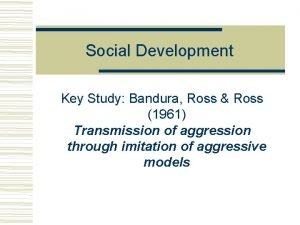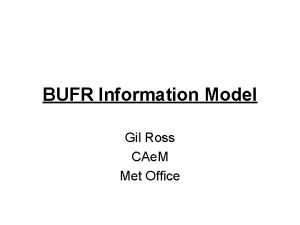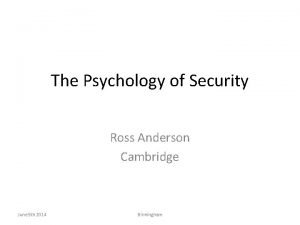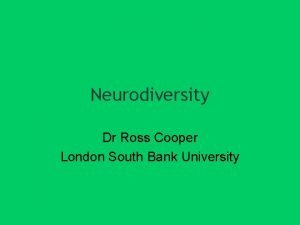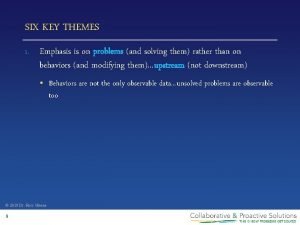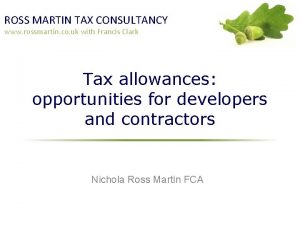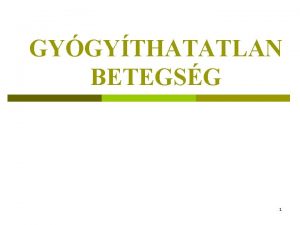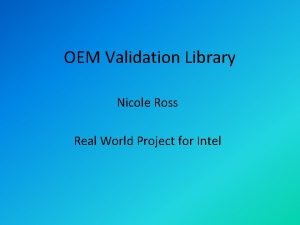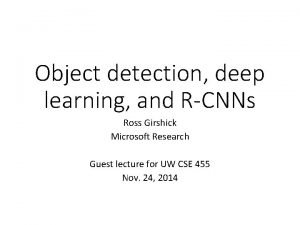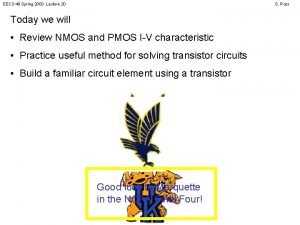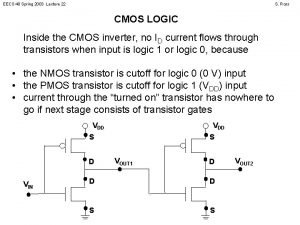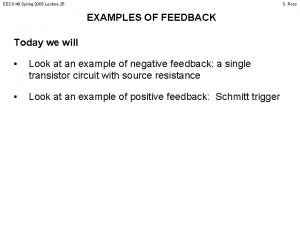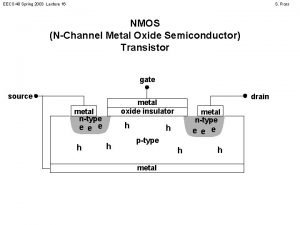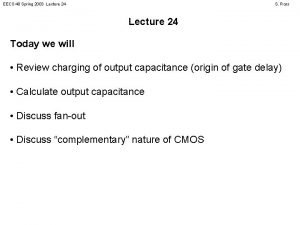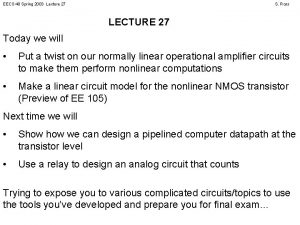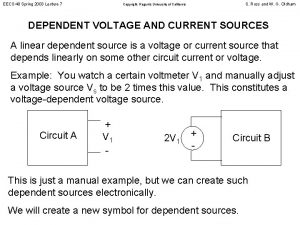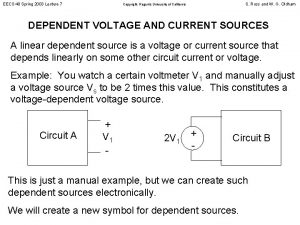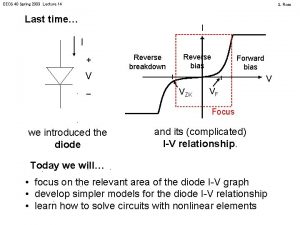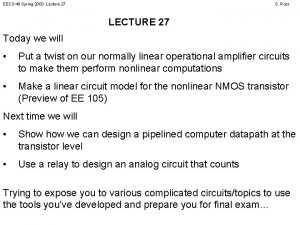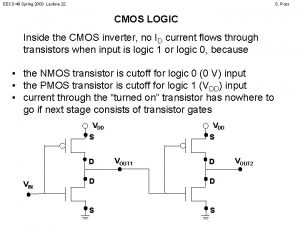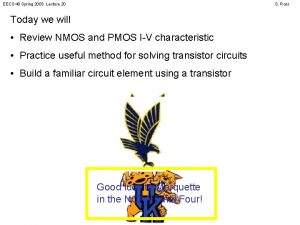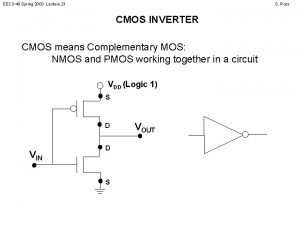EECS 40 Spring 2003 Lecture 14 S Ross















- Slides: 15

EECS 40 Spring 2003 Lecture 14 S. Ross Last time… I I + V _ Reverse breakdown Reverse bias Forward bias V VZK VF Focus we introduced the diode and its (complicated) I-V relationship. Today we will… • focus on the relevant area of the diode I-V graph • develop simpler models for the diode I-V relationship • learn how to solve circuits with nonlinear elements

EECS 40 Spring 2003 Lecture 14 S. Ross DIFFERENT MODELS, DIFFERENT USES • We will consider 4 different diode I-V models with varying degrees of detail. • Use most realistic model only for very precise calculations • Use simpler models to find basic operation, gain intuition • Sometimes one model may lead to an “impossible” situation: use a different (more realistic) model in this case

EECS 40 Spring 2003 Lecture 14 S. Ross REALISTIC DIODE MODEL I I + V _ V • Here, VT is “thermal voltage”: VT = (k. T)/q ≈ 0. 026 V @ 300 o. K (q is electron charge in C, k is Boltzmann’s constant, and T is the operating temperature in o. K) • Equation is valid for all modes of operation considered • You might need a computer to solve the nonlinear equation this model can create

EECS 40 Spring 2003 Lecture 14 S. Ross IDEAL DIODE MODEL I I I + V _ Forward bias Reverse bias + V V _ • Diode either has negative voltage and zero current, or zero voltage and positive current • Diode behaves like a switch: open in reverse bias mode, closed (short circuit) in forward bias mode • Guess which situation diode is in, see if answer makes sense

EECS 40 Spring 2003 Lecture 14 S. Ross LARGE-SIGNAL DIODE MODEL I I + + V _ I Forward bias V Reverse bias + - VF V VF - • Diode either has voltage less than VF and zero current, or voltage equal to VF and positive current • Diode behaves like a voltage source and switch: open in reverse bias mode, closed in forward bias mode • Guess which situation diode is in, see if answer makes sense

EECS 40 Spring 2003 Lecture 14 S. Ross SMALL-SIGNAL DIODE MODEL I I + V _ I + slope = 1/RD Reverse bias + - Forward bias V V VF RD VF - • Diode either has voltage less than VF and zero current, or voltage greater than VF and positive current depending on V • Diode behaves like a voltage source, resistor and switch: open in reverse bias mode, closed in forward bias mode • Guess which situation diode is in, see if answer makes sense

EECS 40 Spring 2003 Lecture 14 S. Ross SOLVING CIRCUITS WITH NONLINEAR ELEMENTS Look at circuits with a nonlinear element like this: Linear circuit IL + VL - INL + VNL - Nonlinear element A nonlinear element with its own I-V relationship, attached to a linear circuit with its own I-V relationship. Equations we get: 1. 2. 3. 4. IL = f. L(VL) INL = f. NL(VNL) INL = -IL VNL = VL (linear circuit I-V relationship) (nonlinear element I-V relationship)

EECS 40 Spring 2003 Lecture 14 S. Ross SOLVING CIRCUITS WITH NONLINEAR ELEMENTS Our 4 equations 1. 2. 3. 4. IL = f(VL) INL = g(VNL) INL = -IL VNL = VL (linear circuit I-V relationship) (nonlinear element I-V relationship) can easily become just 2 equations in INL and VNL 1. INL = -f. L(VNL) 2. INL = f. NL(VNL) which we can equate and solve for VNL, or… graph the two equations and solve for the intersection.

EECS 40 Spring 2003 Lecture 14 S. Ross LOAD LINE ANALYSIS To find the solution graphically, INL graph the nonlinear I-V relationship, -f. L(VNL) graph the linear I-V relationship in terms of INL and VNL (reflect over y-axis), x f. NL(VNL) VNL and find the intersection: the voltage across and current through the nonlinear element.

EECS 40 Spring 2003 Lecture 14 S. Ross EXAMPLE 1 k. W 2 V + - IL + VL _ INL + V_NL Find VNL. Assume realistic diode model with I 0 = 10 -15 A. 1. IL = (VL- 2) / 1000 2. 3. INL = -IL 4. VNL = VL Either substitute into 3. and solve or determine graphically that VNL = 0. 725 V

EECS 40 Spring 2003 Lecture 14 S. Ross

EECS 40 Spring 2003 Lecture 14 S. Ross EXAMPLE REVISITED 1 k. W 2 V IL + - + VL _ INL + V_NL Find VNL. Assume small-signal diode model with VF = 0. 7 V and RD = 20 W. 1. IL = (VL- 2) / 1000 2. INL = (VNL – 0. 7) / 20 or INL = 0 Either substitute into 3. and solve 3. I = -I NL L 4. VNL = VL (VNL – 0. 7) / 20 = -(VNL- 2) / 1000 or determine graphically that VNL = 0. 725 V

EECS 40 Spring 2003 Lecture 14 S. Ross

EECS 40 Spring 2003 Lecture 14 S. Ross ONE MORE TIME 1 k. W -2 V IL + - + VL _ INL + V_NL Find VNL. Assume small-signal diode model with VF = 0. 7 V and RD = 20 W. 1. IL = (VL- - 2) / 1000 2. INL = (VNL – 0. 7) / 20 or INL = 0 Either substitute into 3. and solve 3. I = -I NL L 4. VNL = VL 0 = -(VNL- - 2) / 1000 or determine graphically that VNL = -2 V

EECS 40 Spring 2003 Lecture 14 S. Ross
 Spring summer fall winter and spring cast
Spring summer fall winter and spring cast Bandura sample size
Bandura sample size 01:640:244 lecture notes - lecture 15: plat, idah, farad
01:640:244 lecture notes - lecture 15: plat, idah, farad Fall winter spring summer
Fall winter spring summer Cae ross
Cae ross Ross anderson cambridge
Ross anderson cambridge Dr ross cooper
Dr ross cooper Alsup ross greene
Alsup ross greene Ross martin tax
Ross martin tax Decontextualized assessment
Decontextualized assessment Kübler ross haldoklás fázisai
Kübler ross haldoklás fázisai Ross simms
Ross simms Nicole ross real
Nicole ross real Karen ross and the value of speaking up
Karen ross and the value of speaking up Jim kurose
Jim kurose Ross girshick
Ross girshick

